Chapter 35: Respectful Treatment of Tefillin
1) It is forbidden to hang the tefillin boxes or straps on a peg such that they are suspended in the air, as this is disrespectful to the tefillin.[229]
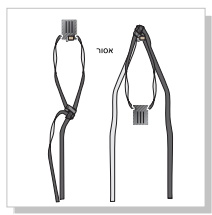
a. When one prepares to put on the tefillin shel rosh, he should preferably hold the box together with the knot, rather than holding one with the other suspended in the air. One should then place the box in its place on the head, followed by the knot. Nevertheless, while donning the tefillin it is permissible to momentarily hold the tefillin box with the straps hanging, or to hold the straps of the tefillin shel rosh with the box hanging.
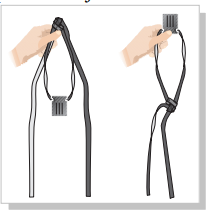
Since this is done as part of the procedure of donning the tefillin, it does not appear disrespectful to the tefillin.[230]
b. If the tefillin are already in their bag, one may hang the bag on a peg such that the bag hangs in the air.[231]
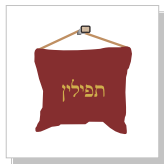
2) There is a custom to observe a fast if one drops his tefillin onto the floor, if they were not in their bag.[232]
a. The authorities debate the question of whether one must fast if the tefillin fell from a height of three tefahim (9-12 inches) or less from the ground.[233] In such a case one should consult with his Rabbi for guidance.
b. If the individual is frail and experiences difficulty fasting, and certainly if he studies Torah and fasting would undermine his ability to properly learn, then in lieu of fasting he should donate to charity the value of one meal.[234] In all such cases one should consult with his Rabbi to determine whether or not he should fast.
c. If the tefillin fell while in their bag or in their plastic case, then one should give charity and is not required to fast.[235]
d. There is a debate among the authorities as to when the fast is observed in a case where a person chooses to fast. The first view maintains that one fasts on that same day when the tefillin fell.236 According to the second view, he should verbally accept upon himself the fast at minhah on that day and then fast the following day.[237] A person should consult with his Rabbi for guidance in such a case.
e. If the day on which one is supposed to fast (either on the day the tefillin fell or on the following day, depending on which view he follows) is a day when fasting is prohibited, such as Shabbat or a festival, then he fasts on a different day. According to all views, on the day of the fast one adds the Anenu section in the Amidah.
3) A person who sees tefillin fall to the ground is not required to observe a fast.[238]
4) If one dropped the tefillin straps on the ground, he is not required to fast; one must, however, ensure that the straps do not drag on the floor.[239]
5) If a pair of tefillin is situated on a bench, one may not sit on the bench while the tefillin are there.[240]
6) If the benches in the synagogue have shelves underneath them on which to place siddurim and the like, and somebody placed his tefillin on such a shelf, then some authorities forbid sitting on the bench, while others are lenient in this regard. All authorities agree, however, that if an empty space the height of a tefah (4 inches) or more separates the tefillin from the bench, one may sit on the bench, as he is then not considered to sit over the tefillin. Nevertheless, even in such a case one should preferably refrain from sitting on the bench given the particular reverence with which one must treat tefillin. One may be lenient if the bench is attached to the wall with nails.[241]
7) One may not eat a meal while wearing tefillin. A “meal” for the purposes of this halachah is defined as at least a kebesah, or 2 oz., of bread, other baked goods, or cooked food made from one of the five principal grains (wheat, oats, spelt, rye and barley).[242]
8) While wearing tefillin one may drink, eat fruits or vegetables, or eat less than 2 oz. of bread or other baked goods. When one eats or drinks with tefillin, he must exercise care not to divert his attention away from his tefillin. If one has completed the prayer service and does not intend to spend some time studying Torah immediately at that point, he should preferably remove his tefillin before eating or drinking even small amounts.[243]
9) One may not sleep, or even take a short nap, while wearing tefillin. This applies even while wearing only the tefillin shel yad or the tefillin shel rosh.[244]
10) One may not place in the bag designated for tefillin other articles, including religious articles of a lower level of sanctity than tefillin, as this constitutes an infringement upon the unique honor that must be afforded to tefillin. Thus, for example, one may not place a mirror or siddur together with the tefillin in their bag. One who wishes to place such items in the tefillin bag should verbally stipulate before he places tefillin in the bag for the first time that he does not designate the bag exclusively for tefillin.
If one keeps the tefillin bag in a larger bag together with his tallit and siddur, he may keep mundane articles in the large bag, as well, since the bag was not designated exclusively for religious articles.[245] In all circumstances, one must ensure not to leave tefillin underneath a tallit or siddur, as the sanctity of tefillin exceeds that of a tallit or siddur.[246]
11) It is forbidden to engage in marital relations in a room where tefillin (or Torah books) are present, unless they are situated behind a partition extending at least ten tefahim (40 inches) high. Alternatively, one may place the tefillin in a כיס בתוך כיס, or “double covering.” Meaning, if the tefillin
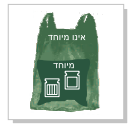
are placed in a bag which is then placed inside another bag, and the outer bag is not designated especially for the tefillin, then marital relations are permitted in the room.[247] The halachic authorities debate the status of the large bag used for one’s tallit, tefillin and siddur with respect to this halachah, whether or not it can be considered a second bag. It is preferable not to treat it as a separate bag, and one should therefore store his tefillin bag in another covering, such as in a shopping bag or a drawer.[248] Couples must be aware of this halacha when lodging in a hotel or visiting somebody else’s home, when the husband’s tefillin is usually kept in the room where they sleep.
12) The small bag designated specifically for tefillin that is no longer used must not be discarded; it must instead be put into genizah (collection of sacred articles that are no longer in use and are therefore buried).[249]
13) One may not bring tefillin into the restroom, even while they are in their bag, unless he has no safe place to keep them while he uses the restroom, such as in an airport or other places where bags cannot be safely left unattended. One may bring tefillin into the restroom if they are in a כיס בתוך כיס, meaning, in a bag which is itself placed in a different bag that is not designated exclusively for tefillin. (As noted above, in halachah 11, it is uncertain whether the large bag used for one’s tallit, tefillin and siddur may be considered a second bag for this purpose.) Thus, for example, if one keeps his tefillin bag in a shopping bag, he may bring the tefillin into the restroom in such a fashion.[250]
14) When removing the tefillin from their bag, one should not shake the bag so that the tefillin will fall out onto the table. He should rather take hold of the tefillin and remove them from the bag. He should then hold the bayit while he prepares the straps, rather than allow the bayit to turn over and dangle as he prepares the straps, which would be disrespectful to the tefillin.[251]
15) When one wraps his tefillin after using them, he must ensure not to wrap the straps directly on the batim (the leather boxes), as the sanctity of the batim exceeds that of
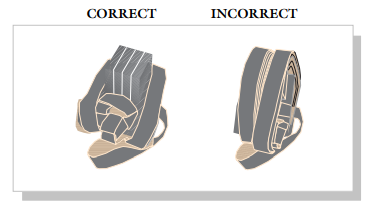
the straps. However, if one keeps his tefillin inside a plastic case (as is the common practice nowadays), he may wrap the straps over the plastic case.[252]
16) The bag in which one keeps his tefillin should be aesthetically pleasing.[253]
17) There is a מנהג חכמים (practice observed by Torah scholars) to kiss the tefillin both when they are put on and when they are removed.[254]
Footnotes
- 229 - שו"ע מ:א ומשנ"ב שם
- 230 - משנ"ב שם
- 231 - שו"ע שם
- 232 - משנ"ב שם
- 233 - עיין כה"ח שכתב דהיכא שנפלו מגובה שהוא תוך ג' טפחים מעל הארץ א"צ להתענות, ויתן מעות לצדקה.אולם הבא"ח לא חילק בזה.
- 234 - כה"ח שם
- 235 - משנ"ב שם
- 236 - כה"ח שם
- 237 - ילקוט יוסף
- 238 - כה"ח מ:א
- 239 - שם
- 240 - משנ"ב מ:ג
- 241 - משנ"ב מ:ה
- 242 - שו"ע מ:ח ומשנ"ב שם
- 243 - שם
- 244 - שו"ע מד:א
- 245 - שו"ע מב:ג ומשנ"ב, ילקוט יוסף
- 246 - כה"ח כח:ג
- 247 - שו"ע מ:ב ומשנ"ב שם
- 248 כה"ח שם
- 249 - משנ"ב שם
- 250 - שו"ע סי'מג
- 251 - משנ"ב כח:ג,וכה"ח שם
- 252 - שם ושו"ת דברי שלמה ח"ב ס' קפד
- 253 - כה"ח כח:ב
- 254 - שו"ע כח:ג

